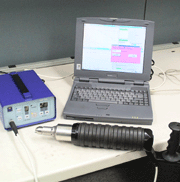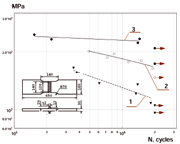E-Archive
Science Update
in Vol. 5 - November Issue - Year 2004
Ultrasonic Peening of Materials, Parts and Welded Elements

Computerized complex for Ultrasonic Peening of materials, parts and welded elements

Fatigue curves of non-load carrying fillet welded joint: 1 - in as-welded condition; 2 and 3 - after application of the UP by using technology A and technology B (optimized)
Intense levels of high frequency acoustic energy, or high power ultrasonics, have found practical use in many industrial processes, of which cleaning, welding and drilling are well-known examples. Other applications include metal forming, treatment of molten metals, chemical processing, and even therapeutic and surgical uses in medicine. In most industrial applications, high power ultrasonics involves power levels of hundreds to thousands of watts, and ultrasonic systems operating in the frequency ranges from 15 kHz to 100 kHz. Typical amplitudes range from about 10 to 40 microns. Such an ultrasonic system operating at 20 kHz creates a cyclic acceleration of around 50,000 g (acceleration of gravity).
One of the most promising directions in using of the high power ultrasonics for industrial applications is the Ultrasonic Peening (UP) of materials, parts and welded elements. The UP technique is based on the combined effect of the high frequency impacts of the special strikers and ultrasonic oscillation in treated material.
The developed system for UP includes an ultrasonic transducer, generator and laptop with software for UP optimum application - maximum possible increase in fatigue life of parts and welded elements with minimum cost, labor and power consumption.
The UP produces a number of beneficial effects in metals and alloys. Foremost among these is increasing the resistance of materials to surface-related failures, such as fatigue and stress corrosion cracking. The UP technology could be applied effectively to elimination of distortions caused by welding and other technological processes, residual stress relief, and increasing of the hardness of materials.
In the fatigue improvement the beneficial effect is achieved mainly by relieving of harmful tensile residual stresses and introducing compressive residual stresses into surface layers of metals and alloys, decrease in stress concentration of weld toe zones and the enhancement of the mechanical properties of the surface layer of the material. The fatigue testing of welded specimens showed that the UP is the most efficient and economical improvement treatment compared with traditional techniques such as grinding, TIG-dressing, heat treatment, hammer peening, shot peening etc.
For the effective application of UP for different materials a software package was developed based on an original predictive model. The main functions of the developed software are:
-determination of the maximum possible increase in fatigue life of welded elements by UP, depending on the mechanical properties of material, the type of welded element, parameters of cyclic loading and other factors
-determination of the optimum technological parameters of UP (maximum possible effect with minimum cost, labor- and power-consumption) for every considered welded element
-quality monitoring of UP process
-final fatigue assessment of welded elements or structures after UP, based on detailed inspection of UP treated zones and computation
The developed computerized complex for UP was successfully applied in different applications for increasing of the fatigue life of welded elements, eliminating of distortions caused by welding and other technological processes, residual stress relief, increasing of the hardness of the surface of materials and surface nanocrystallization.
References
Y. Kudryavtsev, J. Kleiman, L. Lobanov, V. Knysh and G. Prokopenko. Fatigue Life Improvement of Welded Elements by Ultrasonic Peening. International Institute of Welding. IIW Document XIII-2010-04. 2004. 20 p.
Y. Kudryavtsev, J. Kleiman, G. Prokopenko, V. Knysh and L. Gimbrede. Effect of Ultrasonic Peening on Microhardness and Residual Stress in Materials and Welded Elements. SEM International Congress and Exposition on Experimental and Applied Mechanics. Costa Mesa, California, USA, June 7-10, 2004. (on CD)
Y. Kudryavtsev, J. Kleiman, G. Prokopenko, B. Mordyuk, T. Krasovskiy P. Mikheev and V. Knysh. Computerized Complex for Ultrasonic Peening of Parts and Welded Elements. 32-nd Annual Ultrasonic Industry Association Symposium. New York, NY, USA, October 21-23, 2002. (on CD)
Y. Kudryavtsev, J. Kleiman, G. Prokopenko, P. Mikheev and V. Knysh. Mechanism and Efficiency of Ultrasonic Peening in Fatigue Improvement. SEM Annual Conference & Exposition on Experimental and Applied Mechanics. Milwaukee, Wisconsin, USA, June 10-12, 2002. (on CD)
Y. Kudryavtsev, J. Kleiman, G. Prokopenko et al. Optimum Application of Ultrasonic Peening. SEM Annual Conference and Exposition: Experimental Mechanics in Emerging Technologies. Portland. Oregon. USA, June 4-6, 2001. p. 179-182.
Y. Kudryavtsev, J. Kleiman, G. Prokopenko et al. Ultrasonic Peening of Weldments: Experimental Studies and Computation. IX International Congress on Experimental Mechanics. Orlando. Florida. USA, June 5-8, 2000. p. 504-507.
Patent of USA # 6467321. 2002. Device for Ultrasonic Peening of Metals.
PCT WO 02/101097 A1. 2002. Method of Treatment of Welded Joints of Metal Structures by High-Frequency Peening.
For Information:
Integrity Testing Laboratory Inc.
80 Esna Park Drive, Units 7-9
Markham, Ontario L3R 2R7, Canada
Tel.: +1.905.415 2207. Fax: 415 3633
E-mail: ykudryavtsev@itlinc.com
www.itlinc.com




























